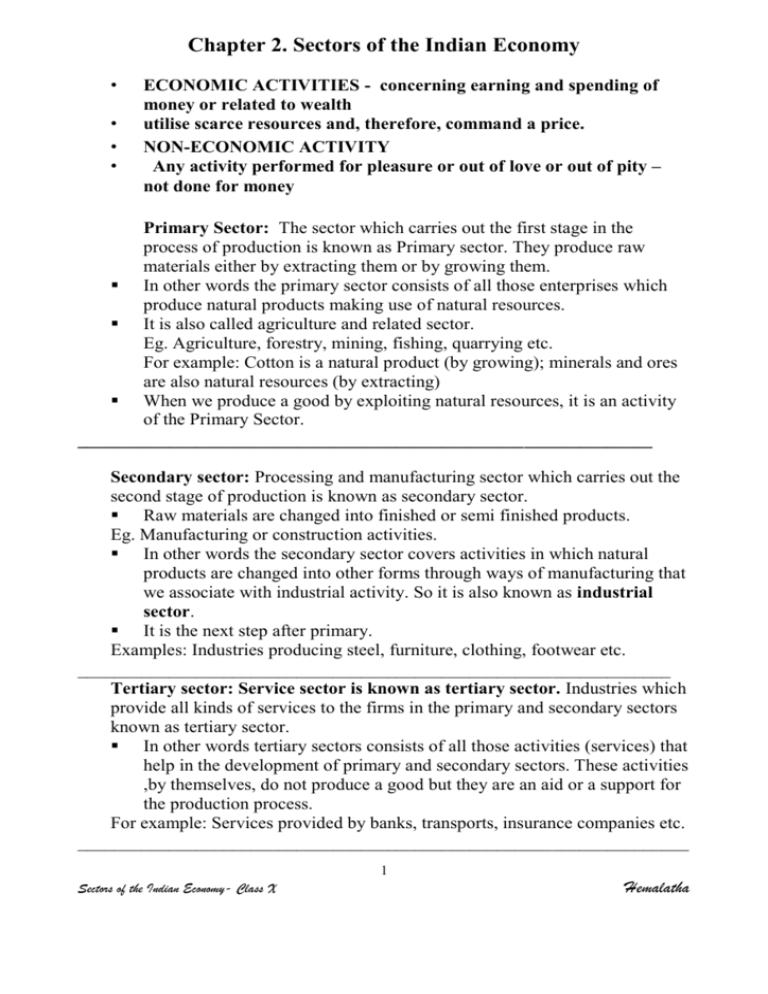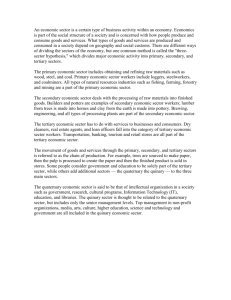Chapter 2 Sectors of the Indian Economy
advertisement

Chapter 2. Sectors of the Indian Economy • • • • ECONOMIC ACTIVITIES - concerning earning and spending of money or related to wealth utilise scarce resources and, therefore, command a price. NON-ECONOMIC ACTIVITY Any activity performed for pleasure or out of love or out of pity – not done for money Primary Sector: The sector which carries out the first stage in the process of production is known as Primary sector. They produce raw materials either by extracting them or by growing them. In other words the primary sector consists of all those enterprises which produce natural products making use of natural resources. It is also called agriculture and related sector. Eg. Agriculture, forestry, mining, fishing, quarrying etc. For example: Cotton is a natural product (by growing); minerals and ores are also natural resources (by extracting) When we produce a good by exploiting natural resources, it is an activity of the Primary Sector. _______________________________________________________________ Secondary sector: Processing and manufacturing sector which carries out the second stage of production is known as secondary sector. Raw materials are changed into finished or semi finished products. Eg. Manufacturing or construction activities. In other words the secondary sector covers activities in which natural products are changed into other forms through ways of manufacturing that we associate with industrial activity. So it is also known as industrial sector. It is the next step after primary. Examples: Industries producing steel, furniture, clothing, footwear etc. _________________________________________________________________ Tertiary sector: Service sector is known as tertiary sector. Industries which provide all kinds of services to the firms in the primary and secondary sectors known as tertiary sector. In other words tertiary sectors consists of all those activities (services) that help in the development of primary and secondary sectors. These activities ,by themselves, do not produce a good but they are an aid or a support for the production process. For example: Services provided by banks, transports, insurance companies etc. ___________________________________________________________________ 1 Sectors of the Indian Economy- Class X Hemalatha Final goods: Final goods are those which are finally used by the final consumers to satisfy their wants and there is no further change in their form or shape. Intermediate goods: are those goods which are used up in the production of final goods. ______________________________________________________________ How do we count the various goods and services and know the total production in each sector? The money value of final goods and services in each sector in an economy during a year provides the value of the total production of that sector during the year. The sum of the money value of production in the three sectors is called the Gross Domestic Product. (GDP). We include only final goods and services in our estimates. We ignore all intermediate goods because it will result in double counting which may not be a true estimate. __________________________________________________________________ Who is responsible for calculating National income or GDP? GDP is undertaken by a central government ministry. This Ministry, with the help of various government departments of all the Indian states and union territories, collects information relating to total volume of goods and services and their prices and then estimates the GDP. __________________________________________________________________ Explain how the classification of economic activities into primary, secondary and tertiary is useful? 1. Looking at the whole economy as one unit will not give a clear picture about the growth and development of different activities. So it is better to have classifications like primary, secondary and tertiary. 2. We can find out the relative contribution of each of the sectors to the growth process. 3. We can find out the output and employment pattern in each of these sectors and changes occurred in them. 4. We can identify easily the problems faced by each of the sectors in the process of economic growth and thereby take necessary remedial measures. _________________________________________________________________ 2 Sectors of the Indian Economy- Class X Hemalatha How do we compare the relative importance of three different sectors in the economy? The relative importance of three different sectors in the economy is compared by using two variables. (i) The percentage share of primary, secondary and tertiary sectors in the national output, that is a. Percentage share of primary sector in the national output b. Percentage share of secondary sector in the national output c. Percentage share of tertiary sector in the national output (ii) Occupational structure – the contribution of each sector in the structure of employment in the country a) Percentage of workforce engaged in the primary sector b) Percentage of workforce engaged in the secondary sector c) Percentage of workforce engaged in the tertiary sector ___________________________________________________________________ What does the history of developed countries indicate about the shifts that have taken place between sectors? A shift in relative importance of different sectors with respect to (a) Generation of income and (b) Generation of employment (i) The history of developed countries indicate that t initial stages of development, primary sector was the most important sector of economic activity. As the methods of farming changed and agriculture sector began to prosper. It produced much more food than before and most people were also employed in this sector. (ii) Over more than hundred years, when new methods of manufacturing were introduced, factories came up and started expanding. In this way, secondary sector gradually became the most important in total production and employment. (iii) During the past 100 years, there has been a further shift from secondary to tertiary sector. The service sector has become the most important in terms of total production and employment. ___________________________________________________________________ What does the comparison between 1973 and 2003 show? (diagram in the book) 1. The relative shares of the three sectors in India’s GDP are undergoing a change 2. Agriculture was the dominant sector in 1973. In 2003, this position has gone to the tertiary sector. 3. Comparatively the share of industrial sector has increased from 1973 to 2003. ________________________________________________________________ 3 Sectors of the Indian Economy- Class X Hemalatha Why is the tertiary sector becoming so important in India? 1. In any country several services such as hospitals, educational institutions, post and telegraphic services, police stations, courts, village administrative offices, municipal corporations, defence, transport, banks, insurance companies, etc are required. These can be considered as basic services. The government has to take the responsibility for the provision of these services. 2. The development of agriculture and industry leads to the development of services such as transport, trade, storage etc. Greater the development of the primary and secondary sectors, more would be the demand for such services. 3. 3. As income levels rise, people start demanding many more services like eating out, tourism, shopping, private hospitals, private schools, professional training etc. 4. 4. Certain new services such as those based on information and communication technology have become important and essential. The production of these services has been rising rapidly. ___________________________________________________________________ “Tertiary sector is not playing any significant role in the development of Indian economy.” Do you agree? Give reasons. (Refer the answer -Why is the tertiary sector becoming so important in India?) The tertiary sector has become the dominant sector. About 25% of total employment is generated in the tertiary sector and about 60% of India’s GDP gets generated in this sector. A number of services produced in the tertiary sector like software solutions are also being exported. These have emerged as big foreign exchange earners for the country. Thus it would be seen that tertiary sector is playing an significant role in the development of Indian economy. ___________________________________________________________________ Why didn’t a similar shift out of primary sector like tertiary sector, happen in case of employment? It is because not enough jobs were created in the secondary and tertiary sectors. Even though industrial output or the production of goods went up by 8 times during the period, employment in the industry went up by only 2.5 times. The same applies to tertiary sector as well. While production in the service sector rose by 11 times, employment in the service sector rose less than three times. Other factors which lead to such situation are: - Lack of education - Lack of skilled labours 4 Sectors of the Indian Economy- Class X Hemalatha - Immobility of agricultural labourers - Superstitious beliefs - Ignorance As a result, more than half of the workers in the country are working in the primary sector, mainly in agriculture, producing only a quarter of the GDP. In contrast to this, the secondary and tertiary sectors produce three-fourth of the produce whereas they employ less than half the people. ___________________________________________________________________ Unemployment: refers a situation wherein a person is willing to work and has the ability to work yet he does not get work. Underemployment: A situation in which a person does not get a job according to his ability or capacity. Disguised unemployment: A situation in which the number of persons employed in a job are more than what are optimally required. It is typical of Indian agriculture where more people are working in a piece of farm than are required. They do not contribute to productive work and when withdrawn do not result in a fall in output. _______________________________________________________ What do you understand by disguised unemployment? Explain with an example each from the urban and rural areas. Disguised unemployment occurs when the number of persons engaged in an activity is more than what is optimally required in a situation. If these extra persons are removed from the activity, there will be no adverse effect on the volume of output. These extra persons may be said to be disguised unemployment. In rural sector, cultivation is the major economic activity. The whole family participates in different operations in cultivation of land. If a few persons are removed from the activity, output will not be adversely affected. Similarly in urban areas we find that the whole family gets involved in small cottage enterprises like roadside shops (petty shops) and artisan activities. In most of these cases, surplus hands get involved in the activity. They do not make any contribution to output. These persons are said to disguisedly unemployed. _________________________________________________________________ Compare and contrast the changes in India with the pattern that was observed for developed countries. What kind of changes between sectors was desired but did not happen in India? In developed countries, the following changes took place: (i) The relative share of agriculture in both GDP and employment fell. 5 Sectors of the Indian Economy- Class X Hemalatha (ii) (iii) The relative share of secondary and tertiary sectors both in GDP and employment increased. Ultimately the tertiary sector of the economy became the dominant sector of the economy. In India, the following changes have taken place: (i) The relative share of agriculture in both GDP and employment has fallen. (ii) The relative share of secondary and tertiary sectors in both GDP and employment have comparatively increased. But secondary sector has neither become the most important sector in terms of production and employment. (iii) There is a shift in tertiary sector, but still its very slow comparatively with the population. As a result, agriculture continues to be the principal source of employment in the economy, although it generates less than 20% of the GDP. ___________________________________________________________________ Why should we be worried about underemployment? Unemployment is a situation in which a worker is able to work only below his ability and capacity. Adverse effects: - Low individual income - Low national income - Low per capita income - Low standard of living - Poverty - Low aggregate demand- low investment -Loss of skill and moral ___________________________________________________________________ How to create more employment? To remove open unemployment, underemployment and disguised unemployment, there is a need to create more employment opportunities. (i) Provision of infrastructure facilities like irrigation in rural areas: Construction of dams , canals, roads will generate many more jobs. This will make agriculture more productive. Farmers can raise two or more crops during a year and they will remain employed throughout the year. (ii) Expansion of transport and trade in rural areas: Building of roads, store houses and other such facilities will create new employment opportunities and it will add income to the people who are unemployed or under employed. (iii) Provision of cheap and easy credit facilities: If the people are provided loans at low rate of interest, they may become self-employed by starting 6 Sectors of the Indian Economy- Class X Hemalatha own business or production. Farmers will be able to buy fertilisers and agricultural equipments and increase their output. (iv) Setting up of industries and services: can provide employment opportunities to many people. (v) Construction of school building, health centres etc: These would not only create more employment opportunities but also contributes to human development. (vi) Promotion of activities like tourism, regional crafts, information etc. can result in creation of more employment opportunities. __________________________________________________________________ Qn. Write about ‘Right to work’ or National Rural Employment Guarantee Act 2005. (or) objective of implementing the NREGA 2005. The central government in India made a law implementing the Right to Work in 200 districts of India. It is called National Rural Employment Guarantee Act 2005. Under this Act (i) All those persons who are able and willing to work have been guaranteed 100 days of employment in a year by the government. (ii) If the government fails to provide employment, it will have to provide unemployment allowance to affected persons. (iii) The types of work that would in future help to increase the production from land will be given preference under the Act. __________________________________________________________________ Qn. Why do you think NREGA 2005 is referred to as ‘Right to work’? (Refer the previous qn- ans) Every able and willing individual has been guarenteed a job for a minimum of 100 days a year under this act. So it is referred to as ‘Right to work’. ___________________________________________________________________ Qn. What ways can employment be increased in urban areas? a) Education should be employment-oriented and it should be compulsory to all children. Vocational education should be imparted. b) Adequate arrangement should be made for provision of training in industrial skills. c) Special emphasis should be laid on promotion of labour-intensive small scale industries. d) Rapid industrialisation e) Career counselling f) Promotion of IT sector g) Promotion of tertiary sector – with increase in education and skill, there will be an increase in demand for different types of services. This may generate new employment opportunities. ___________________________________________________________________ 7 Sectors of the Indian Economy- Class X Hemalatha Qn. Suggest some activities that can be taken up under the NREGA. Building of canals and dams Building of roads Construction of store houses and ware houses Construction of school buildings, health centres and other public utilities Construction of housing The villagers should be given loan at low rate of interest so that they could adopt modern farming techniques and start different non-farming activities. Labour intensive activities will create a large number of jobs. _______________________________________________________________ ____________________ Qn. How would income and employment increase if farmers were provided with irrigation and marketing facilities? a. Irrigation facilities: Irrigation is an important source to increase agricultural output, employment and income. Water is essential for agricultural production. Rainfall in many areas is not only adequate but also uncertain. Construction of dams, canals will generate direct employment. With better irrigation facilities, every farmer will be in a position to raise two or more crops a year from the same piece of land. So income of the farmers will increase. b. Marketing facilities: Marketing facilities include storage facilities of agricultural produces, adequate and cheap transport facilities, information regarding marketing conditions etc. Construction of store houses and ware houses will create direct employment. Provision of better marketing facilities will make the farmers to be in a position to get a better price for their products. Their income will go up. With increase in income levels, farmers will have surplus with them. This can be used to purchase seeds, fertilisers and modern agricultural equipments. This will increase their agricultural productivity, employment and income level. _______________________________________________________________ ORGANISED AND UNORGANISED SECTORS Qn. How are the activities in the economy classified on the basis of employment conditions? Organised sector: It consists of those enterprises which are registered by the government and have to follow various rules and regulations. These are the places of work where the terms of employment are regular and people have assured work. Unorganised sector: It consists of small and scattered enterprises which are largely outside the control of the government. They generally do not follow any rules and regulations. ___________________________________________________________________ 8 Sectors of the Indian Economy- Class X Hemalatha Qn. Compare the employment (working) conditions prevailing in the organised and unorganised sectors. (or) Distinguish between organized and unorganized sectors. Organised sectors Unorganised sectors These are registered by the government and have to follow its rules and regulations which are given in various laws such as Factories Act, Minimum Wages Act, Payment of Gratuity Act, Shops and Establishments Act etc. These are small and scattered units which are largely outside the control of the government. There are rules and regulations but are not followed. It has some formal processes and procedures. No formal processes and procedures. Workers in the organized sector enjoy security of employment. They are expected to work only a fixed number of hours. If they work more, they have to be paid overtime by the employer. They also get several other benefits from the employers. They get paid leave, payment during holidays, provident fund, gratuity etc. They are supposed to get medical benefits and, under the laws, the organization has to ensure facilities like drinking water and safe working environment. When they retire, workers get pensions as well. Employment is not secure. People can be asked to leave without any reason. When there is less work, some people may be asked to leave. Jobs are low-paid and often not regular. There is no provision for overtime, paid leave, holidays, leave due to sickness etc. Qn. Workers are exploited in the unorganised sector. Do you agree with this view? Give reasons. (Refer the Qn -distinguish between organised and unorganised sectors) Page no 31: i. A teacher taking classes in a school – organised sector ii. A headload worker carrying a bad of cement on his back in a market – unorganised iii. A farmer irrigating his field – unorganised iv. A doctor in a hospital treating a patient – organised v. A daily wage labourer working under a contractor – unorganised 9 Sectors of the Indian Economy- Class X Hemalatha vi. A factory worker going to work in a big factory – organised vii. A handloom weaver working in her house – unorganised ___________________________________________________________________ Qn. Do you agree that agriculture is an unorganized sector activity? Why? Yes, Agriculture is an unorganized sector activity. (i) This is because agricultural units are not registered by the government. (ii) Though there are rules and regulations here also, but are not followed. ___________________________________________________________________ Qn. Why more people are in unorganised sector? 1. The employment opportunities in the organized sector have been expanding very slowly. As population rate is very high, these sectors are not able to accommodate all educated, skilled and the people who are able to work. 2. Many organized enterprises are in unorganized sector to evade taxes and refuse to follow laws that protect labourers. As a result, a large number of workers are forced to enter the unorganized sector jobs, which pay a very low salary without any benefits. Qn. How to protect workers in the unorganized sector? Workers in the unorganized sector get low wages which is less than minimum wages. Their jobs are not secure and they have no other benefits. They are often exploited. Hence there is a need for protection and support of workers in the unorganized sector. In the rural areas, the unorganized sector mostly consists of landless agricultural labourers, small and marginal farmers, sharecroppers, artisans. These persons need to be supported through adequate facilities for timely delivery of seeds, agricultural inputs, credit, storage facilities and marketing outlets. In the urban areas, unorganized sector consists mainly of workers in small-scale industries, casual workers in construction, trade and transport, street vendors etc. These sections of the society need to be supported by way of easy credit facilities and other concessions. Protection and support to unorganized sector workers is necessary for both economic and social development. _______________________________________________________________ PUBLIC SECTOR AND PRIVATE SECTOR On the basis of the ownership and management control, enterprises can be classified into two categories. (i) Public sector (ii) Private sector 10 Sectors of the Indian Economy- Class X Hemalatha (i) Public sector: It consists of all those enterprises which are owned and managed by the government. Public sector activities are motivated by social welfare not by profits. Example: DTC, Indian Railways, MTNL, BSNL, Post office etc (ii) Private sector: It consists of all those enterprises which are owned and managed by private capital and enterprise. Private sector activities are motivated by profits. Example: Reliance Industries Ltd, Airtel, Tata Steel, Maruti Suzuki Ltd, Honda Motor Co. etc. Qn. Distinguish between Public Sector and Private Sector Public sector It consists of all those enterprises which are owned and managed by the government. Example: DTC, Indian Railways, MTNL, BSNL, Post office etc Private sector It consists of all those enterprises which are owned and managed by private capital and enterprise.Example: Reliance Industries Ltd, Airtel, Tata Steel, Maruti Suzuki Ltd, Honda Motor Co. etc. Public sector activities are motivated by social welfare not by profits. Private sector activities are motivated by profits. There are certain goods which are There is no such responsibility of the needed by the society as a whole private sector. If they provide these (public goods) like roads, public services, they charge high cost for them. parks etc. There are certain goods which the government used to think the people ought to have (merit goods) like education, health care etc. These are primary responsibility of the government. It provides these services at a reasonable cost or no cost. Qn. Modern day governments spend on a whole range of activities. What are these activities? Why do governments spend on such activities? 1. There are certain goods which are needed by the society as a whole. Individuals cannot be asked to pay a price for using them. These are called 11 Sectors of the Indian Economy- Class X Hemalatha public goods which are produced by the government. Examples:roads, bridges, harbours, dams, public parks, national defence etc. 2. There are some activities which the government has to support. Examples: Supplying electricity at a price which may be less than the cost of production; Supplying fertilizers and seeds to farmers at subsidized prices. 3. The government has to protect the interests of both consumers and producers at times. Examples: Government purchases wheat from farmers at a minimum support price, and sells the same to consumers at a lower price. 4. There are a large number of activities which are primary responsibility of the government. (merit goods) Examples: Provision of quality education and health facilities. 5. The government has to make arrangements for human development such as safe drinking water, housing facilities for the poor and food and nutrition. 6. The government has to take care of the poorest and most ignored regions of the country through increased spending in such areas. _________________________________________________________________ Qn. Explain how public sector contributes to the economic development of a nation. Meaning of public sector 1. Rapid economic growth: the primary objective is to generate and increase the volume of goods and services in the economy. This will increase the national income and percapita income.and ultimately the economic growth of the country. 2. To create employment opportunities (explain) 3. To set up key and basic industries (explain) 4. Balanced regional development (explain) 5. to promote equal distribution of income and wealth 6. It generates financial resources for development 7. It encourages development of cottage and small scale industries 8. It controls private monopolies 9. It ensures easier availability of goods at cheaper rates. ___________________________________________________________________ 12 Sectors of the Indian Economy- Class X Hemalatha









